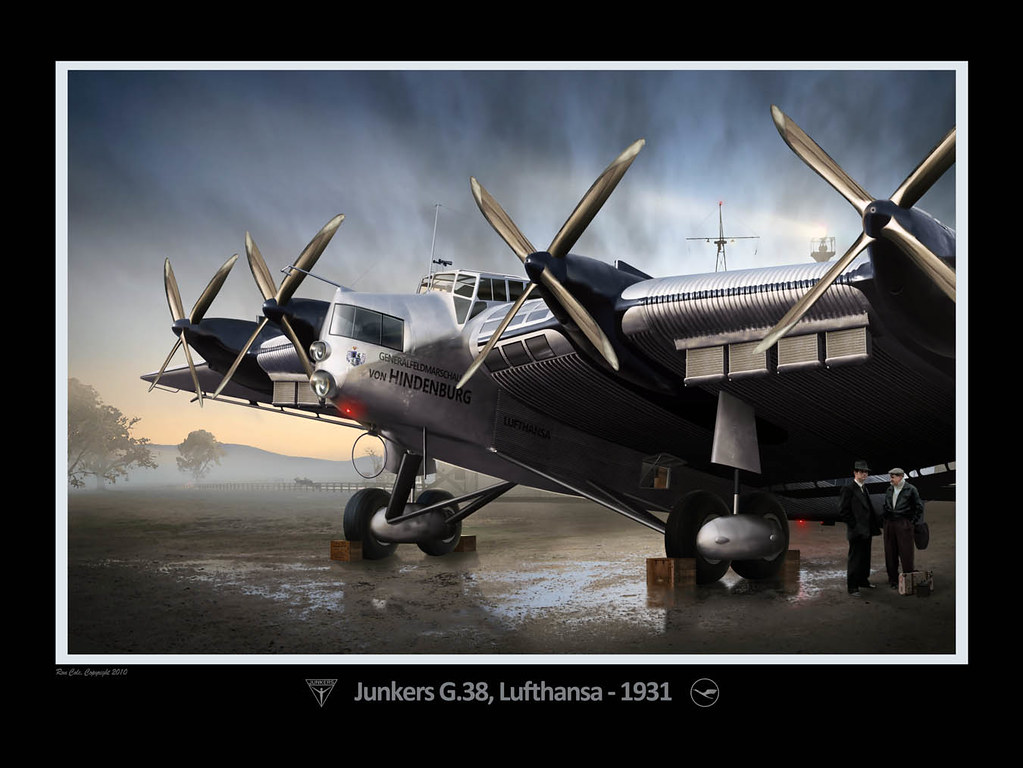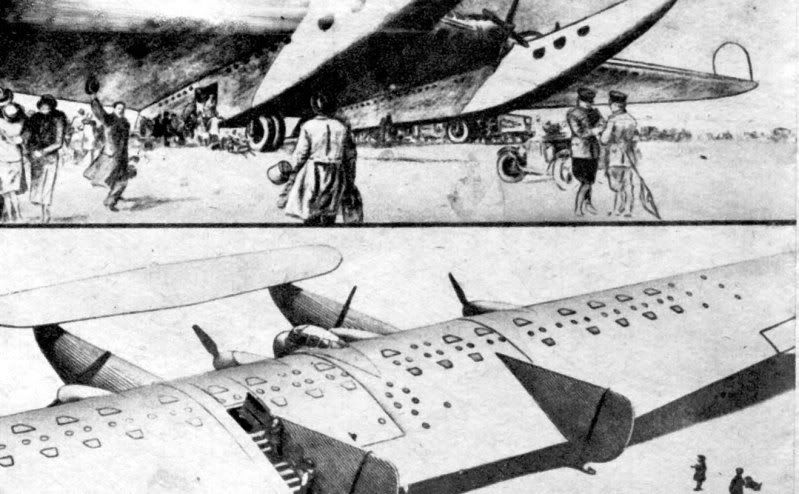
Thought I’d share my latest German piece: The Junkers G.38 flown by Lufthansa before being pressed into the Luftwaffe in WW2.
- Ron Cole


Thought I’d share my latest German piece: The Junkers G.38 flown by Lufthansa before being pressed into the Luftwaffe in WW2.
Nice. Also, you link has a comma in it instead of a period.
Truly beautiful artwork, my dear Mr. Coles. What a talent you have! Hats off to you, Sir!
 You might have some color photo of this machine, isnt that so Librarian ?
You might have some color photo of this machine, isnt that so Librarian ?
excellent work , congratulations for that piece of art 
The impossible we do immediately, but miracles take a little longer, my dear Mr. Panzerknacker. 
Nevertheless, I think that I have something for you and our distinguished artist, honorable Mr. Coles. Namely, this tiny and almost forgotten part of the Junkers engineering history:

Junkers Junkerissime
Although even mighty river Elbe at Dessau-Leopoldshafen is a little bit narrow for this unrealized old birdie, I think that the intrinsic esthetic appeal of our good old Alte Dessauer, which is immortalized in black and white printing technology, still is utterly suitable for the Hohe Düne in Rostock, due to its ability to add a touch of exotic fantasy and a true thrill to that lovely place. Who knows, perhaps this little photo-remembrance will help this truly outstanding effort of our illustrious artist as well. 
And now, you’ll have to excuse me for a moment, my dear Mr. Panzerknacker; I have to find those old renderings of another futuristic design – the Junkers J 1000. But where are those old periodicals… :-?
In the meantime, as always – all the best!
There is an old German proverb stating: “Promises are like the full moon - if they are not kept at once they diminish day by day.”
And the full moon, honorable ladies and gentlemen, has a powerful allure - it is full of beauty, legend, myth and romance. It is the Platonic icon of human inspiration and devotion. According to the Platonic tradition, icons are the visual manifestation of ideas from an intangible, mystical, ideal world. The image and idea were thought to be identical to one another. Thus, icons were seen as a mirror of deep truth. Anyone who worshipped the picture also worshipped the idea embodied in it. The picture functioned as an instrument of communication between the idea and the observable reality.
And today, just like some two millenniums ago, we still do have a strong need for unification of those distinct layers of human importance – the physical illustration and the image of an intangible idea. So here is that already promised, 73 years old illustration:

Junkers J 1000
I hope that your own souls, honorable ladies and gentlemen, will be able to create an ethereal context. It seems to me that in the future this distinctive human ability is destined to pose one of the greatest challenges to the adventure of human being on this island Earth.
In the meantime, as always – all the best! 
Crazy aircraft, far ahead of his time ! look like something extracted from “Metropolis” 
lol looks like the first bombers of the russians … 
I completely do agree with you, my dear Mr.Panzerknacker – that gargantuan “Zukunftseindecker”, equipped with the forward horizontal tail above the catamaran-type of fuselage and 26 separate cabins in the wing capable to hold up to 100 passengers in total, as well as a crew of 10 and fuel for 10 hours of continuous flight, still serves as a reminder that what might be constructively completely acceptable may not always be financially so…
The only thing that still is missing there is some kind of a more streamlined, Rumpler Tropfenwagen approximating variant of the Simson Supra type S touring car (you know, one of the most modern automobile constructions back there in 1924, equipped with a double overhead camshaft valve train and 4 valves per cylinder). In that case we would have been done with a completely suitable set for a famous film The Shape of Things to Come. Alas, it had sunk without trace by the end of the twenties. A tragedy. The Junkers J 1000 deserved a better memorial. 
A tragedy indeed, however I think if mister Junkers keep that canard and no tail configuration it would work heavily to solve more than one stability troubles.
Not necessarily, my dear Mr. Panzerknacker. After all – just call to your mind all those positive experiences connected with the second prototype of the Focke-Wulf F 19 Ente. 
You did a fine selection of words, because the first proto of the Fw 19 went down with Heinrich Focke inside, mister Heinrich didnt make it as probably knew.
Thank you very much, my dear Mr. Panzerknacker. As you know, carefulness is my middle name. 
Personally, I got some very useful hints about this peculiar design variant from a tall, highly unusual Californian with muttonchops sideburns, who advanced aviation technology seemingly all by himself back there in mid eighties. Once upon a time he had a small building at the Mojave airport and employed three people.
His airplanes seemed a little bit odd, because the horizontal “tail” was in the front, while the propeller was usually in the rear, leading some guys to wonder which way they fly. They still fly very well, but the most remarkable thing with his airplanes was that they didn’t stall. A stall, as you know, occurs when the angle between airflow and the wing becomes so grat that the wing loses lift and stops flying. But Burt (that was his name) successfully explained to me that the horizontal tale in front is functioning as a sort of an auxiliary wing. The canard, mounted at a greater angle on the fuselage than the main wing, does indeed stall and stops lifting. Then it drops a little bit and starts flying again. Meanwhile – and that is the point – the main wing has never approached the angle of attack at which it would stall.
As far as i remeber, old Joe Chambers, head of the dynamic stability branch at NASA’s Langley Research Center in Hampton (Virginia), was absolutely delighted with that contraption as well.
Both of them (and Burt’s brother ****, a former Air Force fighter pilot, too!) didn’t let convention to fuzz up their thinking. Canard equipped airplanes indeed may look a little bit odd to those who’ve made up their minds how an airplane should look. Nevertheless, an old, largely self-taught fool like me still thinks that - aerodynamic excellence aside - those unusual airplanes do have an elegance and a simplicity. Like in those good old days, when airplanes - like beefsteaks ! - were bought by the pound…
BTW: If you do like some old magazines, here you have a very interesting one:
http://www.flightglobal.com/pdfarchive/view/1931/1931%20-%200005.html
In the meantime, as always – all the best. 
Wonderful! Well done my friend, it is beautiful.
What medium do you use?
I do miss Librarian. 